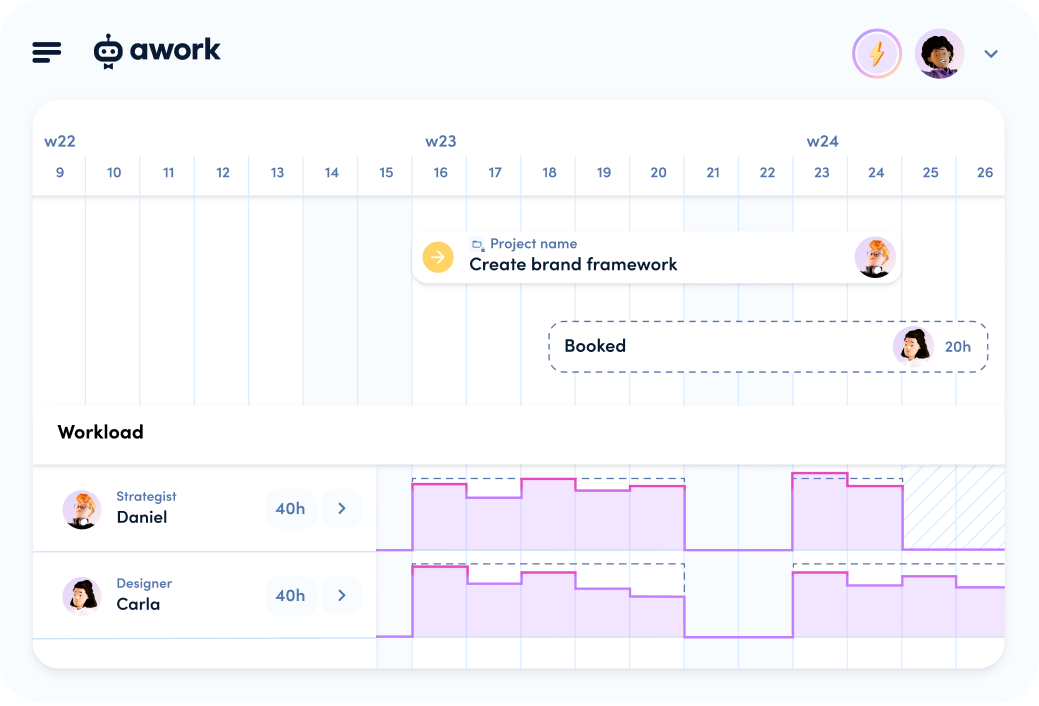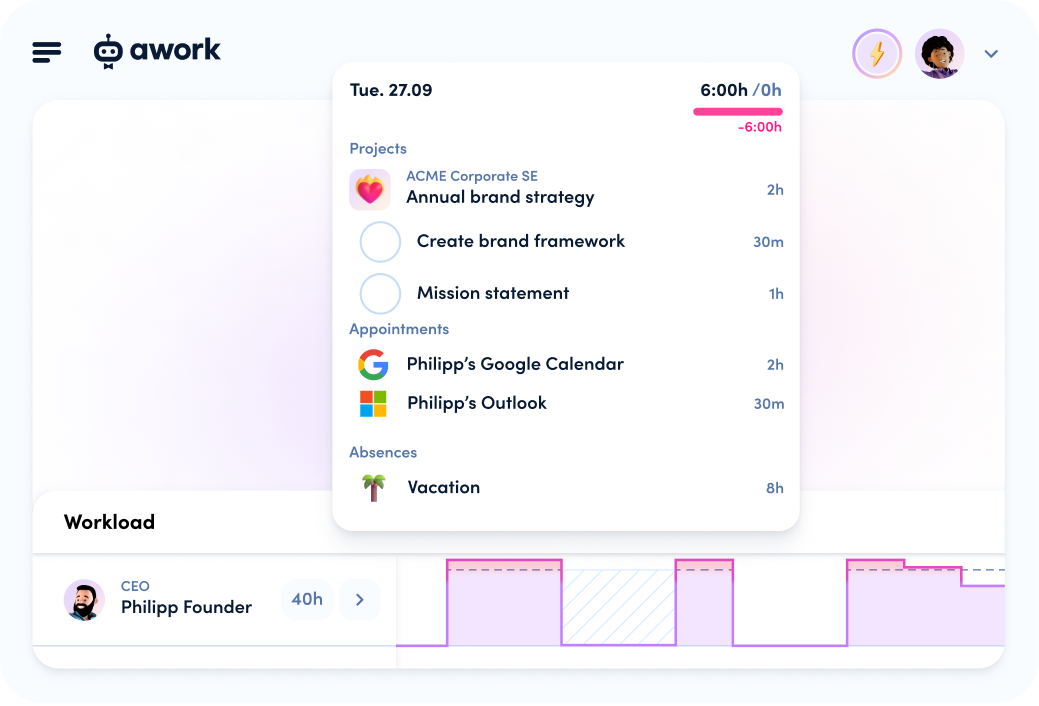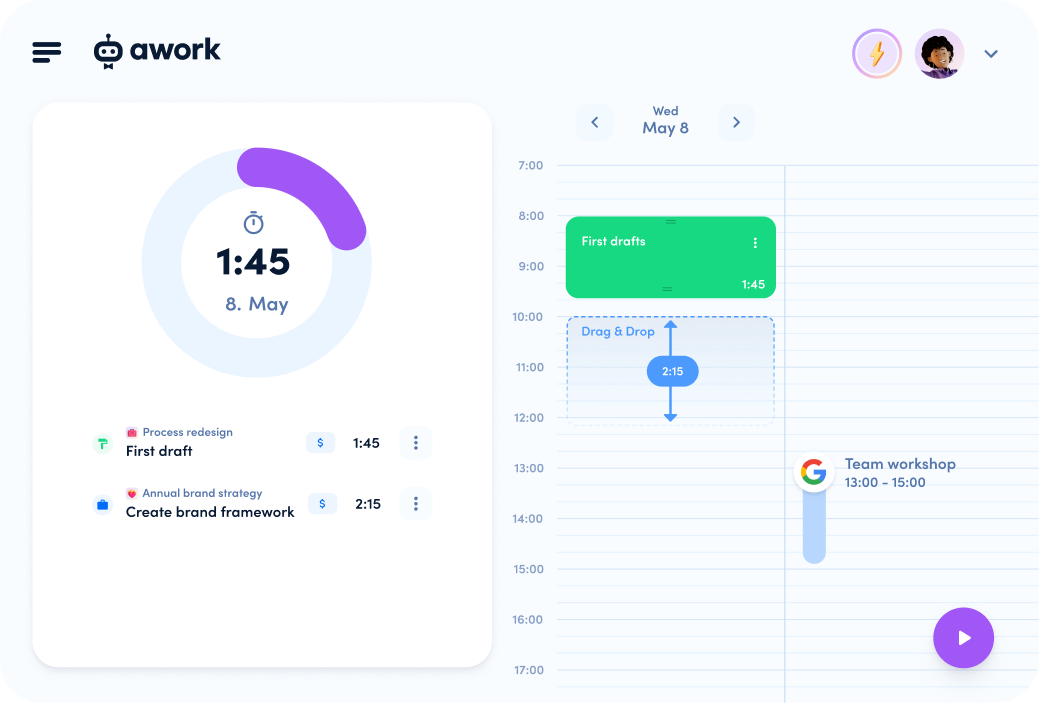In theory, you and each of your team members have eight hours* a day, but who hasn't experienced it: the meeting that takes twice as long as planned, an onboarding workshop with customers, internal training or "can you just" requests that add up. And in the end, the actual project tasks fall by the wayside. Whew.
Before you bury your head in the sand (or rather in the wastepaper basket), we have something for you: tips for clever workload management. In this blog article, we'll show you how to not only tame your team's workload, but really get it purring. 🐱
*Our example is based on a 40-hour week.
The difference between "workload" and "real workload"
For project managers and everyone else in the office jungle, it is important to understand the difference between "workload" and "real workload". "Workload" refers to the total amount of tasks that need to be completed - the "load of work". The capacities of each team member are then filled with these tasks. This means that the planning of workloads not only includes the tasks, but also takes into account how many capas each person actually has free.
It is therefore unrealistic to plan as if you had eight hours a day. The reality: between meetings, ad hoc tasks and other expeditions, there is often only a fraction of the time left for actual work on customer projects.
[.b-important-block]The "real workload" is therefore the capacity that remains after deducting all appointments, workshops and small time wasters.[.b-important-block]
[$tag]👉 Good to know [$tag]

This is THE time you really have for the tasks on the schedule. So project managers keep a close eye on how many to-dos actually fit into a working day - and spoiler: It's not eight hours. 🙈
Of course, this doesn't mean that the rest of the time doesn't "count"; coordination, workshops and stand-ups are fundamentally important parts of day-to-day project management and work. It just means that you have to be realistic when planning the workload for the project tasks - in other words, what workload can still be achieved per day.
What does workload planning mean?
Workload planning - at first it sounds like one of those buzzwords that buzz through meetings. One that everyone nods at, but nobody really knows what it means.
Let's take a closer look at this using an example. Just imagine that workload planning is like organizing a move.
- Take stock: You look at what furniture, boxes and bags you have and sort them by room and importance, for example. This is similar to checking your resources and tasks in project management. You assess which projects currently have priority and who in the team can take on which tasks.
- Set priorities: Then you plan the sequence of your move. You decide what needs to go in the removal van first and what needs to go last. Similarly, in workload management, you determine which tasks need to be completed immediately and which can wait. You make sure that you have enough helpers and that no one is overwhelmed - just as you make sure that the workload is distributed fairly and deadlines are realistic.
- Plan a buffer: When moving, plan extra time because something always comes up - no matter how well you plan. You also build in breaks and provide food and drink to keep everyone in a good mood. Buffer times are also important in project management. And snacks. 🦄
- Distribute workloads: When you're planning workloads in your team, it's a bit like distributing the tasks when you're moving house. You don't want one person to carry all the heavy boxes. Every team member pitches in and you work together to make the project a success.
- Stay flexible: In everyday project management, things sometimes change quickly. A customer suddenly has new requests, a colleague falls ill - you have to be prepared to restructure the plan and deal with the workload.
- Communication and transparency: All crew members should always be aware of the team workloads, who is doing what and why things sometimes change. This keeps everyone in the loop and avoids misunderstandings (applies to project management and relocations 😬).
TLDR? 😬 We got you 👇
- Inventory: You have an overview of the available resources, organize them according to importance and clarify responsibilities.
- Set priorities: You plan which tasks will be tackled first so that you meet important deadlines and no one in the team is overloaded.
- Plan for buffers: Allow for buffers and make sure there are enough breaks to keep the team motivated.
- Distribute workloads: You make sure that the work is divided fairly and that everyone in the team can do their part without being overwhelmed.
- Stay flexible: You adjust plans when requirements change or unexpected problems arise.
- Communication and transparency: You keep everyone in the team up to date on who has which tasks and why adjustments are necessary.
[.b-important-block]When planning workloads, as a project manager you always know what needs to be done when and who will take on the task so that everything runs smoothly. Clever workload planning helps you to keep an overview, work efficiently and keep your team happy.[.b-important-block]
[$tag]👉 Good to know [$tag]
The advantages of workload management
Good workload management brings many benefits that go far beyond the simple "who does what?". Let's take a look at what it really does:

🏆 More accurate schedules
Workload management gives you clear insights into how long the tasks in your team actually take. This helps you to realistically assess what is feasible for your team and what is not. This makes your planning easier and more precise.
With awork time tracking, you and your team can quickly record all times - directly in the tasks. You can also convert appointments from the calendars directly into times. With this information, you can optimise workflows and avoid overloads by distributing the workload fairly and making adjustments in real time.
🏆 Better project quality
Top workload management = top project results. When tasks are clearly assigned and every team member knows exactly what needs to be done, everyone can play to their strengths. This also increases the quality of the results.
🏆 Better communication with customers
With clever workload planning, you can also make more reliable statements to customers. You have a more realistic assessment, can communicate more clearly and know directly how many capas are still available in the event of spontaneous requests. This increases trust and satisfaction on the customer side.
🏆 More satisfaction at work
Clear agreements and transparency strengthen mutual trust. This creates an atmosphere in which everyone has the confidence to contribute ideas or express concerns. If everyone in the team feels that their work is seen and valued, your team members' happiness will also increase.
🏆 Less stress in the team
Good workload management helps you to reduce stress. No more last-minute panic because you know how best to approach and distribute your tasks. If something unexpected does happen, as a project manager you have a plan B.
[.b-important-block] Workload management is therefore not just an organizational tool, but also has a direct impact on how happy your team and your customers are.[.b-important-block]
[$tag]👉 Good to know [$tag]
How do I identify the workload for my team?
You know your team. Each member has their strengths, weaknesses, personal working speed and individual working hours. To manage the workload effectively, you need to understand how much work can realistically be completed within the time available.
Don't just think about the specific tasks that are currently pending, but also about regular meetings and routine daily tasks. Think about how you will distribute the upcoming tasks: Who could best take on which task? These considerations will help you to divide up the work fairly and effectively.
Here are some tips on how you can tackle this:
- Use tools and technologies: Rely on a smart project management tool that gives you insight into the workload, progress and absences of individual team members.
- Personal check-ins: Have regular one-to-one meetings with each team member. This helps you to get a feel for how your crew is doing, what motivates them and where stress factors may lie.
- Analyze work patterns: Try to understand how each team member approaches and completes their tasks. This will allow you to better assign tasks and set realistic deadlines.
- Check performance and results: Take a close look at the results of your team's work. How high is the quality? How quickly are tasks completed? This will help you to adjust the workload and ensure that expectations and goals are clear and achievable.
- Obtain team feedback: Actively involve the team in the workload planning processes. The experiences and perspectives of your team members are particularly valuable for creating realistic plans. This not only boosts the feeling of appreciation, but also improves the accuracy of your workload estimates.
- Make flexible adjustments: Be ready to adjust the plan if you realize that certain tasks are taking more time than expected or a team member is finishing their tasks faster. Flexibility in planning ensures that the workload remains realistic.

What is a work management tool?
A work management tool is practically your command center as a project manager. It combines project management, team planning, personal productivity and time tracking in a single, intuitive platform. These tools are the secret recipe for efficient working by clearly showing everything from deadlines to detailed tasks and helping everyone on the team stay on top of things. With a work management tool, you won't miss any deadlines, team coordination will run like clockwork and everyone can relax at the end of the day.
In short: Work management tools are indispensable for teams that want to work in a structured, goal-oriented and happy way.
[.b-testimonial]The workload overview is extremly helpful. It allows everyone in the team to see individual workloads so tasks are distributed effectively.[.b-testimonial]

How awork supports you with workload planning
awork ploughs through the task jungle, creates clear to-do lists and synchronizes your team quickly and easily. But that's not all:
awork features for planning workloads:
- Real-time overview: imagine starting the day and seeing at a glance in awork that Jonas has less on his to-do list today because a task was completed faster than expected. At the same time, Sarah is up to her ears in a project. With just a few clicks, you can now reassign tasks from Sarah to Jonas.
- Capacities clearly on the screen: You are planning the next quarter and want to create the workload on a solid basis. In awork, you can take a look at the upcoming projects and immediately see what the workload looks like. This allows you to decide early on whether you need additional resources and whether you should perhaps even hire new employees.
- Stay flexible: A client calls and urgently needs a presentation by tomorrow. In awork, you can quickly see who in your crew has time at short notice and redistribute the tasks. The tool shows you where there is room for maneuver and which other tasks need to be postponed. This allows you to communicate with clients much more directly and transparently.
- Who does what? Visualize it: You are preparing for the weekly team meeting and want to show everyone how the projects are progressing. With awork, you can pull up a clear, visual overview of workloads and projects. This allows the whole team to see who is working on what and what the dependencies are.
- Project planning with precision: awork enables precise workload planning because the tool also takes calendar entries and absences into account. You can also realistically plan the content of work packages in advance and avoid silly surprises.
[.b-button-primary]Video: Managing urgent requests smoothly[.b-button-primary]
You 🤝 awork = workload planning 💜
If you are responsible for project management and workload planning - in an agency, a consulting firm or an IT company - you know the chaos that arises when plans are constantly changing. This is where awork comes into play: your support to tame the workload, keep an overview and ensure that your employees don't drown in stress.
With awork, you can keep an eye on everything: Which projects are running, who is currently working on what and who may already have too much on their desk. It helps you to keep an eye on the workload, distribute workloads fairly and ensure that no one is overloaded. It also makes communication within the team and with customers easier because everyone knows the current project status at all times.
If you would like to learn more about our awork planner, take a look at our professional planner webinar.
Sounds like an application for your project management that you could use? Try awork for free for workload planning and see for yourself how it can ease your work-to-dos and workload issues.
[.b-button-primary] Curious? Try awork for free! [.b-button-primary]























